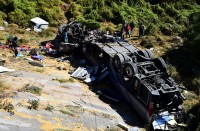By Michel COMTE
OTTAWA, Aug 17, 2023 (AFP) – Residents of one of the largest cities in Canada’s far north were ordered Wednesday to flee amid warnings that raging wildfires could reach it by the weekend.
The crisis in the town of Yellowknife is the newest chapter of a terrible summer for wildfires in Canada, as flames spread quickly across the country, forcing tens of thousands of people to evacuate and charring vast swathes of land. More than 1,000 wildfires are burning across the vast country.

“Unfortunately, our wildfire situation has taken another turn for the worse with a fire burning west of Yellowknife now representing a real threat to the city,” Shane Thompson, the Northwest Territories’ environment minister, told a news conference.
He ordered the city’s nearly 20,000 residents to leave by noon Friday. There is only one highway open to the south. Commercial and military flights were also being arranged.
The wildfire as of late Wednesday was within 17 kilometers (11 miles) of Yellowknife, which is the regional capital.
“I want to stress that the city is not in immediate danger,” Thompson said.
But he added: “Without rain, it is possible (the fire) will reach the city outskirts by the weekend.”
“You put yourself and others at risk if you choose to stay later,” he said.
Yellowknife declared an emergency earlier this week, which was soon expanded across the vast northern territory as firefighters were forced to pull back in some areas.
Strong winds have stoked the flames, and several towns and Indigenous communities are already under evacuation orders.
– Largest ever evacuation –
In what had already been declared the Northwest Territories’ largest ever evacuation, Yellowknife’s evacuation now means half the population of the near-Arctic territory will soon be displaced.
The Canadian military on Monday started airlifting residents of many smaller communities in the Northwest Territories after roads were engulfed in flames. For many, it was the second time in recent months that residents were forced to leave their homes.
Images shared on social media and on Canadian television showed an orange smokey haze over the region, large swaths of blackened forests, and melted headlights and peeled paint from the heat on those cars and trucks that made it through to safety before several roads became undrivable.
A man named Jordan Evoy told AFP this week he’d been forced to turn back after fires jumped across the highway in front of him in “the scariest moment of my life.”
“Flames were jumping over my truck” and he said he worried its tires would melt in the heat. “The asphalt was on fire.”
This season, megafires have spread across Canada with remarkable intensity, forcing 168,000 people to flee their homes and scorching 13.5 million hectares (33.4 million acres) — almost twice the area of the last record of 7.3 million hectares, according to the Canadian Interagency Forest Fire Centre.
Four people have died so far in this year’s wildfires.
As of Wednesday, there were nearly 1,100 fires still burning across Canada, including more than 230 in the Northwest Territories.







